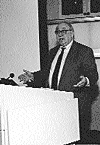| Osgood/Thesis
Day | Robert
Bailey Osgood Lecture | Senior Residents
Thesis Presentations Back to HOJ HOME |
 visit our website at: www.lunarcorp.com | click here to view full page ad |
|
Osgood/Thesis Day
May 5, 1999
|
|
Introduction
of Osgood Essayist
Henry Mankin,
MD
The Orthopaedic Service is pleased and proud to invite you to yet another Osgood Day - which as you know celebrates the contributions of our great former Chief of the Orthopaedic Service - Robert Bayley Osgood. The lecture and events that will take place today and tonight when we hold our annual year end dinner are made possible by a generous gift of Ellen Jennings, Dr. Osgood's daughter.
|
Robert Bayley Osgood was born in 1873 in Salem, Massachusetts of an old New England seafaring family which emigrated from Hampshire, England to the colonies in the year 1638...clearly very early in the history of our country. Robert attended Amherst College and received a degree in classics in 1895 and subsequently received an honorary degree from that institution some years later. In 1895 he entered Harvard Medical School and received his doctorate with the last class of the nineteenth century in 1899. During medical school Bob became very interested in Orthopaedics, chiefly because of the influence of the influence of the great clinicians of those days - Edward Bradford, Elliot Brackett, and Joel Goldthwaite - and he was determined to pursue a career in our specialty. He first interned at The House of the Good Samaritan, and then at the Massachusetts General Hospital and at the conclusion of his formal training (things were different then) he entered practice with Joel Goldthwaite and Charles Painter, first at the Carney Hospital and subsequently, from 1904 to 1922, at the MGH. He became the Chief of the Orthopaedic Service in 1919 following his war experiences, but then was lured to Children's in 1922 to become Chief there and the first John Ball and Buckminster Brown Professor of Orthopaedics at Harvard Medical School. |
 |
Bob's activities in these positions were extraordinary. He was, without a doubt, an outstanding clinician. Adept at diagnosis, remarkable in his perceptions-particularly of the new technology-the x-ray, gentle and kindly in his approach to his patients, and truly an outstanding surgeon. He became famous for his approaches to polio; his studies on arthritis; his operative procedures such as the osteotomy about the knee; his understanding of scoliosis; and, perhaps in his most extraordinary research, his description of the abnormality of the insertion of the patellar tendon - which resulted in the now timeless and will last forever, eponymic marriage of our Bobby with Dr. Schlatter on the alter of the tibial tubercle. But Bob was much more than thatÉ
He was a patriot. He, like many surgeons, volunteered to serve with the Harvard Unit under the direction of Harvey Cushing. But when he arrived in England he almost immediately became fast friends with Sir Robert Jones and together they did much to alleviate suffering and improve the quality of orthopaedic care, first for the British forces and subsequently for the American expeditionary force. Robert Jones, the leader of British Orthopaedics, once said of Bob Osgood, "he was a whole-hearted searcher for truth, singularly unfettered by tradition, and a gentle critic of calm and sound judgement".
He was a teacher. He loved to teach and did it brilliantly. With gentle touch and remarkable knowledge he extracted educational efforts from all his students who adored him. He wrote beautifully and as is fitting for a classicist, in perfect and graceful English.
He was a
statesman. Bob loved the American Orthopaedic Association - of which he
was one of the early members - and participated in the founding of the
Canadian Orthopaedic Association. It was at his suggestion that the British
finally founded and developed the British Orthopaedic Association and
he became one of their first honorary members (along with similar status
in the Italian, Scandinavian, Australian, and Belgian societies).
Finally Bob was a passionate friend to many; he cared for his family;
enjoyed his home in Ipswich; loved his daughter; and would have certainly
enjoyed his grandchildren and great grandchildren.
So we are here today to once again honor our Robert Bayley Osgood; orthopaedic clinician and scientist; scholar; teacher; patriot and family person. No finer flower have we seen in Boston Orthopaedics.
Our Osgood Essayist has many of the attributes of our hero, Robert Bayley Osgood. Joseph Buckwalter was born in Iowa, attended college and medical school at the University of Iowa and took his residency there. He, like Osgood, who never left Boston, has never left Iowa, remaining on the faculty at the University and rising in a short time to the rank of Professor. Jody is, as you will discover shortly, a superb teacher and gifted lecturer - but not without an enormous knowledge base in science and in clinical practice. He is the successor to Michael Bonfiglio on the tumor service in Iowa and is a credit to the institution and Mike. He is a superb experimental scientist as well as a committed member of the research community. Jody has done work in the field of cartilage structure and biology and especially the studies related to technology attempting to cure cartilage defects. I feel very privileged to have been a co-author with Jody on a number of studies.
Jody is tireless. In addition to all the things that I have listed above, he has been the president of the Orthopaedic Research Society and The Board and is now the Second President-Elect to the American Orthopaedic Association. He's the co-editor of the prestigious Journal of Orthopaedic Research. It is a great pleasure to greet Jody and thank him for honoring us with his presence.
Robert Bailey Osgood Lecture | Senior Residents Thesis Presentations
TOP OF PAGE | HOJ HOME